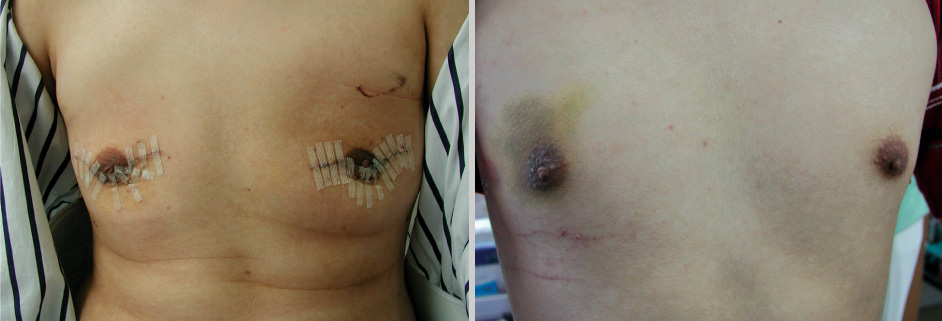J Breast Cancer.
2010 Mar;13(1):27-30. 10.4048/jbc.2010.13.1.27.
Treating Gynecomastia with Ultrasound-guided Vacuum-assisted Biopsy Device as a Cosmetic Method
- Affiliations
-
- 1Breast and Thyroid Center, Chungmu General Hospital, Cheonan, Korea. breast4ryu@paran.com
- KMID: 2286556
- DOI: http://doi.org/10.4048/jbc.2010.13.1.27
Abstract
- PURPOSE
Gynecomastia can cause severe emotional phobia for breast cancer in elderly male and physical distress in young men. To select the appropriate cosmetic surgical approach for gynecomastia, I evaluated the usefulness of performing ultrasound-guided vacuum-assisted device excision of it.
METHODS
Twenty-two cases of gynecomastia in 18 male were treated by vacuum-assisted biopsy device excision from November 2005 to June 2007. Their age range was 14-72 years old (mean, 34). The vacuum-assisted biopsy device excision was performed by 11G needle in 7 cases and 8G needle in 15 cases. I checked the number of extracted tissue pieces, the duration time of the procedure, immediate complications, and breast ultrasound after 3 months.
RESULTS
The mean number of extracted tissue pieces was 69, and the average procedure duration was 25 minutes. There were no significant immediate complications such as bleedings and skin necrosis, and there were no clinically serious complications on 3 months follow-up examinations. During operation under local anesthesia, all patients tolerated the procedure. After vacuum-assisted biopsy device procedure, the cosmetic results were good to excellent for all the patients.
CONCLUSION
Vacuum-assisted biopsy device excision was an effective surgical option, especially for small and glandular gynecomastia. I suggest this is a useful alternative procedure to surgery and liposuction, or it could be used effectively as a co-operative procedure with liposuction.
MeSH Terms
Figure
Reference
-
1. Czajka I, Zgliczynski W. Gynecomastia-pathogenesis, diagnosis and treatment. Endokrynol Pol. 2005. 56:269–277.2. Bembo SA, Carison HE. Gynecomastia: its features, and when and how to treat it. Cleve Clin J Med. 2004. 71:511–517.
Article3. Mentz HA, Ruiz-Razura A, Newall G, Patronella CK, Miniel LA. Correction of gynecomastia through a single puncture incision. Aesthetic Plast Surg. 2007. 31:244–249.
Article4. Mathur R, Braunstein GD. Gynecomastia: pathomechanisms and treatment strategies. Horm Res. 1997. 48:95–102.
Article5. Simon BE, Hoffman S, Kahn S. Classification and surgical correction of gynecomastia. Plast Reconstr Surg. 1973. 51:48–52.
Article6. Park MJ, Kim KJ, Kim YM, Ryu JW. Clinical analysis and comparison of Mammotome biopsy between 8G and 11G probes. J Korean Breast Cancer Soc. 2003. 6:186–188.
Article7. Kevin DJ, Christopher S. Patient satisfaction and changes in pain scores after ablative laparoscopic surgery for stage III-IV endometriosis and endometriotic cysts. Fertil Steril. 2003. 79:1086–1090.
Article8. Ersek RA, Schaeferele M, Beckham PH, Salisbury MA. Gynecomastia: a clinical review. Aesth Sur J. 2000. 20:381–386.9. Gikas P, Mokbel K. Management of gynecomastia: an update. Int J Clin Pract. 2007. 61:1209–1215.10. Colombo-Benkmann M, Buse B, Stern J, Herfarth C. Surgical therapy of gynecomastia and its result. Langenbecks Arch Chir Suppl Kongressbd. 1998. 115:1282–1284.11. Hall-Craggs MA, Vaidya JS. Minimally invasive therapy for the treatment of breast tumors. Eur J Radiol. 2002. 42:52–57.12. Singletary SE. Minimally invasive technique in breast cancer treatment. Semin Surg Oncol. 2001. 20:246–250.13. Fine RE, Boyd BA, Whitworth PW, Kim JA, Harness JK, Burak WE. Percutaneous removal of benign breast masses using a vacuum-assisted hand-held device with ultrasound guidance. Am J Surg. 2002. 184:332–336.
Article
- Full Text Links
- Actions
-
Cited
- CITED
-
- Close
- Share
- Similar articles
-
- The Role of Ultrasound-Guided Vacuum-Assisted Removal of Gynecomastia
- The Role of Ultrasound-Assisted Liposuction before a Surgical Excision in the Treatment of Gynecomastia
- Comparison of needle aspiration and vacuum-assisted biopsy in the ultrasound-guided drainage of lactational breast abscesses
- Usefulness of Ultrasound-guided Mammotome Biopsy for Microcalcification
- Usefulness of Ultrasound Guided Vacuum-Assisted Mammotome Biopsy for Breast Lesion


